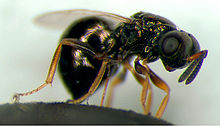- Nasonia
-
Nasonia 
Nasonia vitripennis Scientific classification Kingdom: Animalia Phylum: Arthropoda Class: Insecta Order: Hymenoptera Family: Pteromalidae Subfamily: Pteromalinae Genus: Nasonia
Ashmead, 1904Species Nasonia giraulti
Nasonia longicornis
Nasonia vitripennisSynonyms Mormoniella Ashmead, 1904
Nasonia are a genus of small pteromalid parasitoid wasps that sting and lay eggs in the pupae of various flies. The fly species that Nasonia usually parasitize are primarily blowflies and fleshflies, making Nasonia a useful tool for biocontrol of these pest flies. The wasps are small, pinhead sized, and also referred to as jewel wasps.
The wasp genus has acquired genes from the Pox virus and from Wolbachia in less than 100,000 years.[1]
There are currently four described species in the Nasonia genus, N. vitripennis, N. longicornis, N. giraulti, and N. oneida. N. vitripennis is found worldwide; N. giraulti is found in eastern North America and N. longicornis is found in western North America.
Genomics
In 2010 the Nasonia genome was announced after work over four years by an international consortium of research groups financed by the National Human Genome Research Institute.[1][2] It is expected that the discovery will lead to applications in pest control.
References
- ^ a b Tiny wasp with potential for big impact, SFGate, David Perlman, Chronicle Science Editor.
- ^ The Nasonia Genome Working Group (15 January), Functional and Evolutionary Insights from the Genomes of Three Parasitoid Nasonia Species, 5963, 327, pp. 343–348, doi:DOI: 10.1126/science.1178028, http://www.sciencemag.org/cgi/content/full/327/5963/343, retrieved 2010-01-15
- Nasonia resources hosted at the University of Rochester
This chalcid wasp-related article is a stub. You can help Wikipedia by expanding it.
